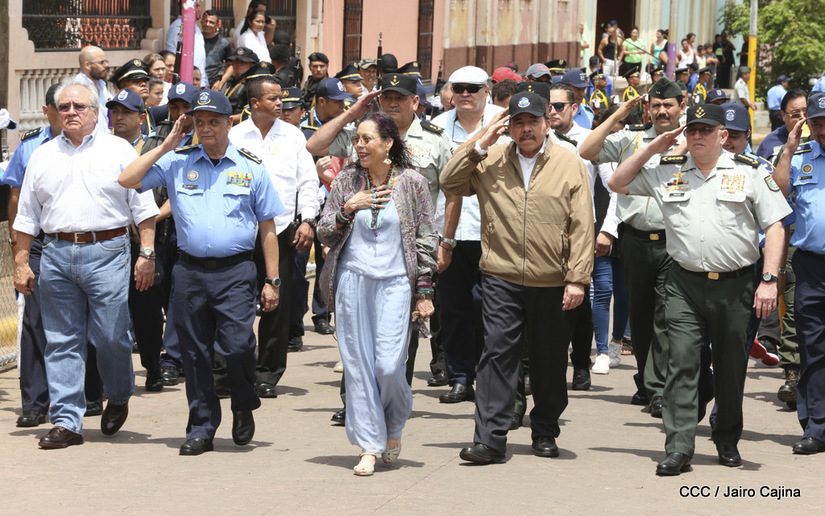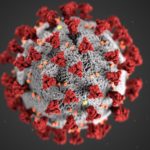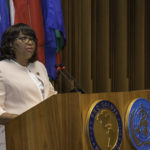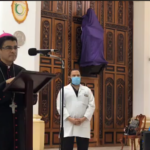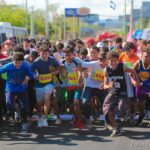This weekend, the Ortega-Murillo government experienced moral and public relations defeats, after ineptly handling Eddy Montes’ death and its aftermath. As is customary, the administration pretended that press releases and public spectacle would sufficiently calm local and international public outrage.
Indeed, as citizens of Matagalpa gathered in mourning and protest, Daniel Ortega and Rosario Murillo commemorated one more anniversary of the birth of Sandino. On Saturday, May 18, a large entourage escorted the duo to Niquinohomo, where flanked by police and army officers, Ortega delivered a speech, in which he remembered the deaths Edwin Castro Rodríguez, Ausberto Narváez, and Cornelio Silva.
The three men were political prisoners of Anastasio Somoza Debayle. They were gunned down by the National Guard (GN), presumably while trying to flee the jail known as “La Aviación”, The Airfield.
The government’s propaganda machine continued ignoring the news in Matagalpa and Managua, churning out stories about Sandino homages across the country. Followers of el19digital, for example, were informed about the young people of Bluefields, who planted ornamentals to honor Sandino.
Con la siembra de plantas Ornamentales en la Plaza General George Hodgson en Bluefields, la Juventud Sandinista de esta ciudad conmemoró el 124 aniversario de natalicio del general Sandino pic.twitter.com/57QfOSavKT
— El 19 Digital (@el19digital) May 18, 2019
All celebrations went on with “much joy, revolutionary strength, and love for the motherland.”
Con mucha alegría, fuerza revolucionaria y llenos de amor por la patria, grandes y chicos honran el legado inmortal del general Augusto C. Sandino, hoy 18 de mayo, día en que se cumplen 124 años de su natalicio pic.twitter.com/4aRFJTG95T
— El 19 Digital (@el19digital) May 18, 2019
Outside of the Ortega-Murillo Propaganda Bubble, Repression Operates.
In spite of the stream of banality published by the Ortega-Murillo propaganda media, repression continued mercilessly.
On Friday, a heavy police contingent surrounded the Cathedral of Managua, to prevent a picket demanding justice for Eddy Montes. Zayda Hernández, a student leader and founding member of the Movimiento Universitario 19 de Abril, shared this video of the police deployment. According to Hernández, police had surrounded the cathedral and were “interrogating everyone who wanted access.”
La policia sandinista se encuentra en este momento rodeando todo el perímetro de la catedral de Managua.
Una simple manifestación es motivo suficiente para un despliegue policial.
Están ubicados en cada entrada del templo interrogando a todos los que quieren ingresar. pic.twitter.com/smvJfTmJ4V
— Zayda Hernández (@ZaydaMu19a) May 17, 2019
Hernández was abducted shortly after shooting the footage, but not before an Ortega-Murillo sympathizer taunted and catcalled her. He can be heard off camera, yelling, “How does the failure of your coup attempt feel?” and “are you going to a zumba competition, honey? You should dance hard, so you can lose some weight.”
Analizando el video en donde se vió por ÚLTIMA VEZ a Zayda Hernández:
1-Un sapo la estaba grabando y siguiendo.
2-A pocos metros había un patrulla de la Policía Nacional.
3-Los militares se habían tomado todo Managua.
4-Ellos dicen que no la tienen.
Ya van 24hr de desaparecida. pic.twitter.com/ClYMxE9u49— El Córdoba Hoy (@elcordobahoy) May 18, 2019
Hernández was missing about 48 hours, but she was not the only abductee on Friday. Gustavo Adolfo Méndez also disappeared on Friday afternoon. The young man also turned up on Sunday afternoon at the Manolo Morales hospital. He showed signs of a beating. He did not speak to the press.
Gustavo Adolfo Méndez, detenido hace más de 48 horas, en las inmediaciones de la Catedral de Managua, fue encontrado el día de hoy en el Hospital Manolo Morales, luego de una golpiza de la PO, permanece custodiado como si se tratara de un delincuente #SOSNICARAGUA pic.twitter.com/XNrr6QDEDN
— 🇳🇮Joshy💙💙💙💙💙💙 (@JoshyCastillo) May 19, 2019
As for Zayda Hernández, she was left at the gate of the Managua Cathedral. On Monday, she gave a press conference at the offices of the Comisión Permanente de Derechos Humanos (CPDH), a Nicaraguan human rights advocacy group. Hernández said that she was headed to the picket at the Cathedral, but had been blocked from entering by police.
“The police that guarded the entry yelled insults; they threatened me with arrest.”
Hernández was able to flee the spot on a taxi cab, but her cab was stopped by at least four armed individuals, driving a white pick up truck. They were dressed in civilian clothes. Hernandez says that they blindfolded and forced her onto the bed of the pick up. “They warned me that if I yelled out or talked, they would kill me.”
Hernández was taken to an unknown location. She was forced to wear a hood, doused with alcohol, the entire length of her captivity. The alcohol fumes prevented her from opening her eyes. She was also tied, and forced to stay awake for the duration, through beatings.
“They interrogated me. They asked me who was financing me, and how much money I paid people to protest. They also asked me who was behind the attempt to overthrow the government, who was behind the sanctions, who were the traitors to the motherland, and why we had sold out Nicaragua to the empire.”
The captors threatened her family and told her to sign a confession, repenting from her participation in protests.
Hernández’ ordeal ended when her captors drove her back to the Cathedral of Managua and left her by the gate on the west side of the grounds, her hands and feet still bound with zip ties. The driver and passengers of a passing vehicle rendered aid. They took Hernández to the sacristy, where nuns called her family and the media to ensure her safety, as police was still deployed around the building. She reunited with her family shortly after.
🔴 EN VIVO || Líder estudiantil Zayda Hernández aparece con signos de golpes en su cuerpo.
>> Seguí nuestra transmisión en: https://t.co/WhSJy99LEw pic.twitter.com/thJRDJYt0e— LA PRENSA Nicaragua (@laprensa) May 20, 2019
Local and international pressure likely played a role in forcing Hernández’ release, as even OAS Secretary General Almagro called upon the Ortega-Murillo government to investigate her disappearance. Almagro tweeted out this cropped picture, showing both of them during Hernández visit to OAS headquarters in Washington, DC.
Es imperativo y responsabilidad del Estado nicaragüense esclarecer la desaparición de Zayda Hernández. Se debe realizar todo lo necesario para que Zayda pueda regresar con los suyos en forma inmediata. pic.twitter.com/T0yhp6RZkY
— Luis Almagro (@Almagro_OEA2015) May 19, 2019
The Ortega-Murillo administration responded to Hernández’ dissappearance through a press release, in which, without referring to the victim by name, they spoke of a “defamatory campaign, based, as usual, on lies. We denounce similarly the so-called ‘fake positives, that seek sparking negative reactions against Nicaragua.”
The police also responded, by inviting Hernández to press charges against her abductors. The press release was issued before Hernández had said anything to the press. Nevertheless, the police PR division writes: “Declarations given by a lady that said she was kidnapped and beaten have just been made known.”
"Declaraciones brindadas por una señora que dijo"…
¿LEÍ BIEN?
¿QUIÉN LES HABRÁ REDACTADO ESTO?👇 pic.twitter.com/b2wcFNc3We— Cristhian Alvarenga (@CrisAlvaLopez) May 20, 2019
When asked if she would take the police up on their offer to investigate, Hernández said that she would do so “on the same day that they start investigating the murder of Alvarito Conrado.”
Alvaro Conrado was among the first victims of the repression. He was shot through the neck on April 20. He died due to denial of medical attention at the Cruz Azul hospital in Managua.
Alianza Flexes Muscle.
On Friday, the Alianza Cívica did not attend the negotiations at the INCAE, in protest for the death of Eddy Montes and the ensuing beatdown of political prisoners, which left at least 17 people injured. By Monday, the coalition was calling for a general strike “in the upcoming days.” In a press release, the Alianza listed Montes’ death, the lack of progress in the release of political prisoners, and the government’s unwillingness to fulfill the agreement they had signed as evidence of “lack of political will.”
Shortly after, the Interior Ministry (MIGOB) announced it would excarcerate 100 prisoners, which were identified as individuals who “had committed crimes against common safety and pubic peace.” MIGOB indicated that the excarcerations were a “unilateral decision of the government” and that the ICRC would be participating as observers. As usual, MIGOB published full names and ID numbers for all individuals it was transferring to house arrest.
The excarcerated prisoners include Dilon Ramos, from Matagalpa, a college student.
Dilon Ramos ya se encuentra en Matagalpa con su familia. Ramos es estudiante de la UNAN FAREM Matagalpa y parte de los 100 #PresosPoliticos con convivencia familiar. #SOSNicaragua pic.twitter.com/qmN7y7bt2M
— [Presos Políticos Nic] (@PresoPoliticoNi) May 21, 2019
Orlando Valverde and Augusto Gutiérrez, from Diriamba
Orlando Alexander Valverde Ortiz, excarcelado el día de hoy, originario de Diriamba, ya se encuentra en su casa de habitación.#SOSNicaragua pic.twitter.com/eHAsjq95F5
— [Presos Políticos Nic] (@PresoPoliticoNi) May 21, 2019
Augusto Gutiérrez es recibido por su familia y amigos en Diriamba, Carazo. #SOSNicaragua pic.twitter.com/WLMyOGbqBh
— [Presos Políticos Nic] (@PresoPoliticoNi) May 20, 2019
Chester Navarrete, a paramedic from Masaya, who was imprisoned for rendering aid to the wounded. Navarrete said that “repression must cease. The dictatorship must cease. The Nicaraguan people must be left in peace.”
"Que cese la represión… Que deje al pueblo de Nicaragua en paz", es la petición del excarcelado Chester Navarrete, quien estuvo seis meses detenido en el Sistema Penitenciario Nacional. @laprensa pic.twitter.com/h8HnmFgNyc
— Lidia López (@Lidia_LopezB) May 20, 2019
Domingo Lacayo, of Jinotepe
Preso político Domingo Lacayo es llevado hasta su casa en Jinotepe, Carazo. Entró gritando "de que se van, se van". En el microbus en el que trasladaban a los demás presos políticos también gritaron por la libertad de Nicaragua, contra la dictadura, y "Eddy Montes ¡Presente!". pic.twitter.com/YENJzTsoII
— [Presos Políticos Nic] (@PresoPoliticoNi) May 20, 2019
María Adilia Cerrato, of Masaya. She and her husband Christian Fajardo are leaders in the M19 movement of Masaya. Fajardo was not released.
💙🇳🇮 María Adilia Peralta Cerrato, esposa de Cristhian Fajardo y líder del M19 Masaya, ya camino a su casa 💙🇳🇮
¡Libertad para todas y todos!
#SOSNicaragua pic.twitter.com/AgEZiry5gZ— 🆘🇳🇮 Ocupa Inss (@OcupaINSS) May 20, 2019
Kysha Lòpez, of Diriamba. López is a transgender woman who was accused of financing the barricades in the city.
La presa política trans, Kysha López, también fue excarcelada. Ella había sido acusada de financiar tranques en Diriamba, y condenada a en los tribunales orteguistas a 40 años de prisión. #SOSNicaragua pic.twitter.com/IZo09JxFi6
— [Presos Políticos Nic] (@PresoPoliticoNi) May 20, 2019
OAS Permanent Council Meets on Tuesday.
The events that have transpired since Eddy Montes’ death do not favor the image that the Ortega-Murillo administration insists on projecting. Normalcy is not consistent with facts on the ground. People get abducted regularly, prisoners are beaten and abused, one man is dead, and access to the main Catholic temple in the country remains difficult.
Del 13 al 20 de mayo hubo 21 secuestros realizados, por el régimen de Daniel Ortega.#UnidadNacional pic.twitter.com/OogDm8hKYy
— Unidad Nacional Azul y Blanco (@UnidadNic) May 20, 2019
This is the state of play, as the Ortega-Murillo administration faces another special session of the OAS Permanent Council on Tuesday afternoon.
📆 𝗠𝗔𝗥𝗧𝗘𝗦 𝟮𝟭 𝗱𝗲 𝗺𝗮𝘆𝗼 𝗱𝗲 𝟮𝟬𝟭𝟵 𝗮 𝗹𝗮𝘀 𝟭𝟰:𝟯𝟬 𝗘𝗦𝗧
Sesión extraordinaria del Consejo Permanente de la #OEA para tratar “La situación en #Nicaragua"https://t.co/qRCJPVSNkl pic.twitter.com/Ibk3yD2Gal
— OEA (@OEA_oficial) May 20, 2019
